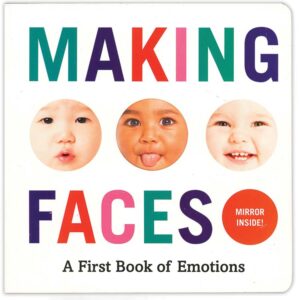Awareness of emotions
A toddler explores ways to communicate and respond to some common emotions.



[Invite a toddler to look at pictures of children’s faces.]
We are learning about different ways we can feel inside. We know about feeling happy, and we know about feeling sad.
 [Show book cover. Point to the faces.]
[Show book cover. Point to the faces.]
Our book shows different types of faces. Let’s look at each face and talk about what the child may be feeling. Our book is called Making Faces.
[Use the following approach to each pictured face:
Everyone can feel the ways we talked about. It is okay to feel sad or angry or happy or silly or surprised.
A toddler may try to make a face similar to the pictured face. Acknowledge this effort. “You are showing me a sad face.”
Some toddlers may need support for identifying the pictured face among the collection of five faces. One approach is to point to 1–2 pictures and ask if the baby looks like he/she is feeling the emotion under discussion.
The examples of how we can respond to feeling sad and angry are different from the other three emotions explored in this activity. The suggestions (sad: get a hug; angry: take a deep breath) are among some positive ways to deal with these emotions. Suggestions for the other three emotions focus on ways to express an emotion, such as laughing when we feel silly. Encourage the toddler to talk about other things we might do when we feel sad or angry or other ways we can show we are happy, silly, and surprised.
Look for ways to emphasize the names of emotions shown in the five pictures and to encourage the toddler to say the emotion name. An important step in emotion awareness is to be familiar with emotion names.
The pictured faces intended to show surprise and silly may be difficult for a toddler to identify. There are many ways children and adults can communicate feeling surprised and silly through facial expressions. You may ask the toddler to show what his/her face looks like when he/she is feeling surprised (or silly).
This activity option extends the attention to feelings in Blocks 16 and 17 (Social-Emotional). The book was featured in a Block 18 activity for younger toddlers (12–24 months) with a focus on facial expressions.
Extra support
Enrichment
Awareness of emotions
Toddlers sing about and show facial expressions for some common emotions.



Be Prepared: This activity is for toddlers who are familiar with the five feelings shown in the Making Faces book featured in Option 1. Be familiar with the tune of the “If You’re Happy and You Know It” song.
 Invite 4–6 toddlers to join in singing about different ways we can feel. Show the book cover and review each of the five large pictures that show a child communicating a specific feeling. Encourage toddlers to say the name of the feeling. Repeat the name. Suggest a way we can show or deal with what we are feeling, as follows:
Invite 4–6 toddlers to join in singing about different ways we can feel. Show the book cover and review each of the five large pictures that show a child communicating a specific feeling. Encourage toddlers to say the name of the feeling. Repeat the name. Suggest a way we can show or deal with what we are feeling, as follows:
Then invite toddlers to stand and sing a verse of “If You’re Happy and You Know It” for each feeling. Preview the key phrase, such as “get a hug,” prior to singing the verse. Do actions when appropriate, such as clapping your hands, pretending to give or get a hug, and taking a deep breath. Accentuate “oh my” with voice and facial expression when you say it.
The familiar tune of the song encourages toddlers to think about an emotion shown in facial expressions and in prior discussion without the task of learning a new song. This promotes the self-regulation skill of short-term memory and offers another opportunity to say an emotion word.
The activity is more challenging than Option 1 because it involves song, some actions, and activity alongside peers. The popular song is featured in the Communication/Language activity in the current block with different physical movements requested in the song.
Some toddlers may prefer to watch, whereas others may enjoy doing the actions but prefer not to sing.
Extra support
Enrichment
Materials Needed: Making Faces: A First Book of Emotions by Abrams Appleseed, Baby Faces by Margaret Miller, 3–4 nonbreakable, handheld mirrors in different sizes
Place a basket of 3–4 mirrors in a comfortable reading area along with the suggested books. Invite toddlers individually or in small gatherings to look at faces in the books, and to explore their own reflections in the mirrors. Some toddlers may make different faces in the mirrors, whereas others may enjoy exploring their facial and hair features. Talk with the toddlers about what they see.
Materials Needed: Different mirrors, including the Interest Area materials and mirrors affixed to walls
Children of all ages enjoy seeing their reflection in a mirror. Babies can look at themselves in a large mirror affixed to the wall, and older children will enjoy use of a full-length mirror to observe themselves dressing up and playing different roles. Encourage preschool-age and older children to show emotions that are more challenging to communicate in facial expressions, such as feeling frustrated or proud.